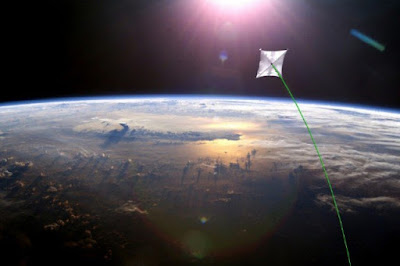 |
| Philip Lubin's laser sail concept |
A lot of science fiction these days amounts to fantasy dressed up in scientific language, and that can be entertaining, but it's not true speculative fiction; it's a flight of the imagination. This kind of speculation has so influenced science lately that even scientists are stooping to fantasy.
Philip Lubin's recent statement that with current technology we can travel to Mars in 30 minutes is an example of this. Many are pointing out the problems with his proposal, such as space debris, braking and the energy required. But here's another practical detail he seems to have missed: The affects of acceleration on the human body. Maybe someday we might propel an object to Mars in 30 minutes, but getting it there by the means he describes requires accelerating it half the way and deccelerating it half the way.
You can see the limits to this without consulting a mathematician: At its closest approach, Mars would be about 35 million miles away. Half of that is 17 million miles. If our complete trip is supposed to last 30 minutes, we have to cover the first 17 million miles in 15 minutes, or 900 seconds of acceleration.
Let's be charitable and say our astronauts only have to accelerate one mile per second each second to get this vast distance, though they would need to go much faster than that. 1G acceleration is about 32 feet per second faster each second. One mile per second each second is 165 times more acceleration, so that's 165 G's, right? Tell me if I'm missing something here. That's more than enough to smush any astronaut.
Lubin is not alone in skipping the realities of interplanetary travel. In a way, he's being more realistic than others who propose taking a year or more to travel to Mars. I've mentioned the problems with this in a previous post ("Around Mars in 500 days"). The only practical way for humans to travel to the planets is by getting there fast. In my novel, Beyond Earth, I propose a 1G drive, where the astronauts accelerate at 1g for half the journey and decelerate at 1g for the other half. It would make for a comfortable ride and shorten the journey to about two days. Of course, someone has yet to invent a 1G drive, so that's where imagination comes in.
Philip Lubin's recent statement that with current technology we can travel to Mars in 30 minutes is an example of this. Many are pointing out the problems with his proposal, such as space debris, braking and the energy required. But here's another practical detail he seems to have missed: The affects of acceleration on the human body. Maybe someday we might propel an object to Mars in 30 minutes, but getting it there by the means he describes requires accelerating it half the way and deccelerating it half the way.
You can see the limits to this without consulting a mathematician: At its closest approach, Mars would be about 35 million miles away. Half of that is 17 million miles. If our complete trip is supposed to last 30 minutes, we have to cover the first 17 million miles in 15 minutes, or 900 seconds of acceleration.
Let's be charitable and say our astronauts only have to accelerate one mile per second each second to get this vast distance, though they would need to go much faster than that. 1G acceleration is about 32 feet per second faster each second. One mile per second each second is 165 times more acceleration, so that's 165 G's, right? Tell me if I'm missing something here. That's more than enough to smush any astronaut.
Lubin is not alone in skipping the realities of interplanetary travel. In a way, he's being more realistic than others who propose taking a year or more to travel to Mars. I've mentioned the problems with this in a previous post ("Around Mars in 500 days"). The only practical way for humans to travel to the planets is by getting there fast. In my novel, Beyond Earth, I propose a 1G drive, where the astronauts accelerate at 1g for half the journey and decelerate at 1g for the other half. It would make for a comfortable ride and shorten the journey to about two days. Of course, someone has yet to invent a 1G drive, so that's where imagination comes in.
No comments:
Post a Comment